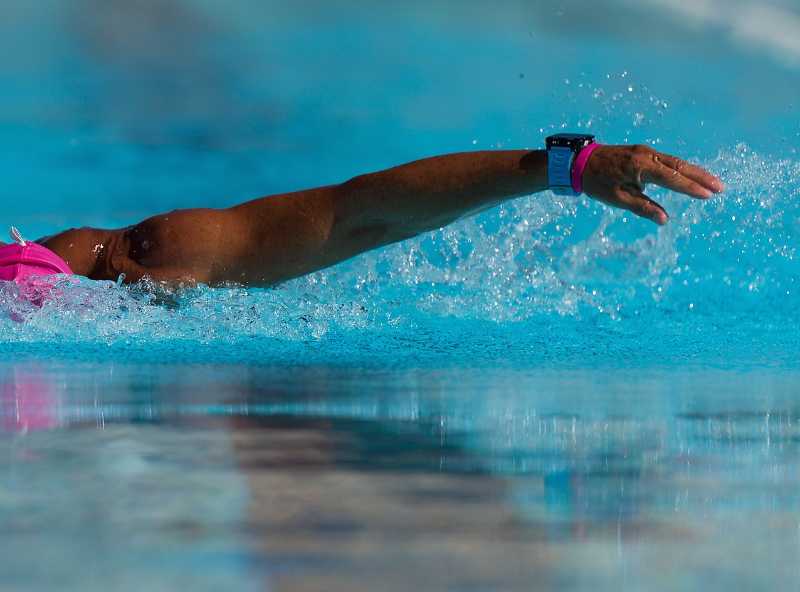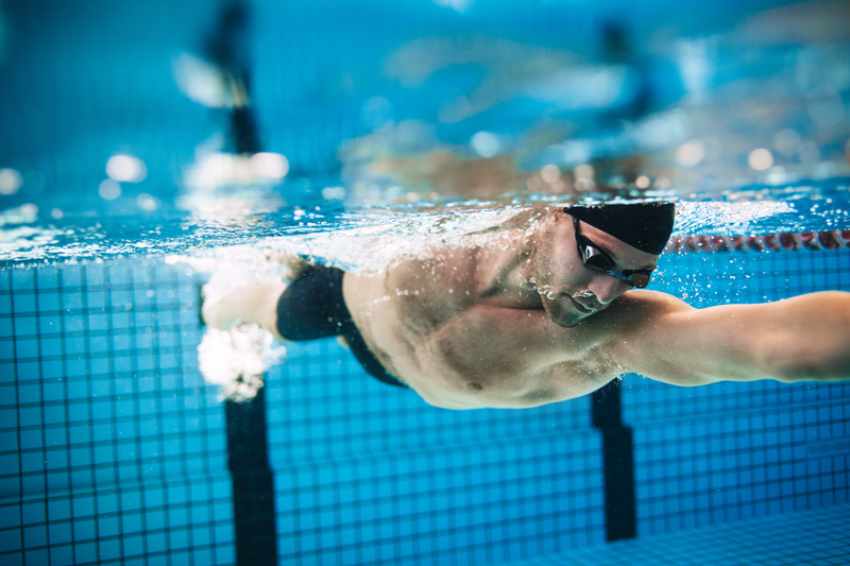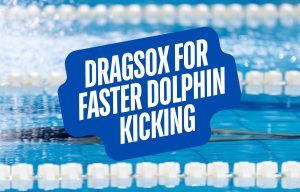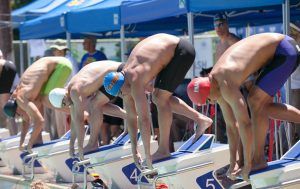Swimming laps is one of the best ways to get healthy and get in shape. Counting laps, on the other hand, can often feel frustrating. Here’s a look at the best ways to count laps when swimming, the tools to use, and how Olympic swimmers count laps at the pool.
As an experienced swimmer, I’ve lost count more times than I can… well… count.
For new swimmers, trying to wade through and understand all of the different lingo and terminology can be frustrating.
Especially when it comes to counting laps and counting distance.
Meters. Yards. Short course. Laps. Lengths.
There’s a lot going on here.
Fortunately, it gets simpler once you understand a couple of quick terms.
In this article, we will look at the key things to know about counting laps, the best ways to count your laps in the pool, and how to easily determine how much distance you have with your laps.
Let’s dive right in!
What is a lap in swimming?
One of the longest-running debates in the swimming community is whether it’s a lap or a length.
For the sake of brevity, a lap or a length is one crossing of the pool. Whether swimming in a 25-yard, 25-meter, or 50-meter swimming pool, if you swim across the pool once, that is one lap or length.
If you swim there and back, that is two laps (or two lengths).
Waterproof fitness trackers like smartwatches and smart swim goggles track laps this way, too.
Each time you swim to the wall, regardless of the length of the pol (which we will look at more in-depth shortly), the trackers mark that as a completed lap (length).
How far is a lap in swimming?
There are three pool distances:
25-meters. This is also known as short course, or short course meters. This distance is found primarily outside of the United States, who prefer to use yards for their short course swim pools.
50 meters. This is the pool size you see when watching the Olympics every four years. All of the main international swim competitions are held at this distance.
25-yards. Yard-length pools are almost exclusively found in the United States. High school swim associations, NCAA Swimming, and USA Swimming hold swim meets in yards.
How far an individual lap is comes down to the length of your swim pool.
To determine how far you have gone over the course of your swim workout, simply multiple the number of lengths times the distance of the pool.
- 100 laps in a 25-yard swim pool (100×25) = 2,500-yards
- 100 laps in a 25-meter swim pool (100×25) = 2,500-meters (Or 2,734 yards)
- 100 laps in a 50-meter swim pool (100×50) = 5,000-meters (Or 5,448 yards)
Next, we will look at some ways to count your laps.
How to Count Your Laps While Swimming
Count by the # of lengths
The way each of us counts laps vary. Even the same swimmer can use different strategies to stay on top of how many laps they’ve done in the water. Counting laps by the number of reps is the simplest way to keep track of your laps.
The trouble with this strategy is that once you get up there in laps, and your brain wanders, you will find yourself wondering if you just did lap 10 or if this lap is 10.
Count by distance.
Counting individual laps gets tedious, fast. Think about it, if you swim for an hour, covering 3,000m in that time, that is 120 laps of a short course swimming pool.
That’s a huge number to track over the course of an hour.
A way to reduce the number counting is pairing down the laps into digestible chunks, into distance.
For example, if you are doing 3,000m, it’s going to easier to count 30x100m versus 120 laps.
Other ways to count by distance is by “chunking” your swim workout with different skills. Using our 3,000m example, you could break it apart by doing 100m swim and 100m pull, repeated ten times.
So instead of counting up to 120 laps, you simply have to count fifteen “rounds” alternating the swim and pull.
Tip: Break your swim workout into digestible chunks (sets) that makes it easier to count. As we will see shortly, this is the way competitive and Olympic swimmers do it.
Swimming smartwatch
Okay, now we are going to get into waterproof fitness trackers, which include smartwatches, smart swim goggles, and lap counters.
Starting off–smartwatches designed for the pool!
Smartwatches are a great way to measure every aspect of your swim training, including laps and distance swum.

They are great for pools that don’t have pace clocks (you can use the watch as an interval timer), they track your heart rate, and yes, they count your laps even when swimming in a pool that isn’t one of the standard lengths (a 22-yard pool, for example).
There are plenty of excellent swim watches (and smartwatches that have swim apps) on the market, including the usual suspects like Apple, Garmin, FitBit, and more.
The range of options is almost endless with smartwatches. The app ecosystem has grown significantly in recent years as well, giving you a huge variety of options for counting your laps (and just about everything else you are doing in the water).
Watches are an excellent option for swimmers who want a tool to automatically and accurately count laps during swim training.
Smart swim goggles
Tech has come a long way for swimmers in recent years, with all sorts of awesome wearables proliferating the sport.
Possibly the coolest tech development of them all is smart swim goggles.
These specialized swim goggles, including the FORM Swim Goggles and the FINIS Smart Swim Goggles, have heads-up-displays inside the goggle lens that display all manner of data and metrics, including time elapsed, splits, and yes, distance swum.
During my testing with the FORM Swim Goggles, I was a little (okay, a lot) blown away by how accurately the goggles tracked my laps and splits. The FINIS Smart Goggles also performed very accurately, and an added benefit of the FINIS goggles is that you can edit your workout post-swim in its app.
For swimmers who like to do long, unbroken swims at the pool, and want to ensure an accurate lap count, a set of smart swim goggles can give you immediate feedback on laps swum from the time you push off until that final effort down the home stretch.
The developers of the FORM and FINIS goggles are also experienced competitive swimmers, which results in a goggle and corresponding app that understands the unique requirements of tracking swims.
Lap counter
Another tool for counting your laps in the swim pool is using a visual counting device (looks like an abacus).
Each time you do X number of laps (2, 4, etc), you simply move one of the markers to the side to denote completion.
This is one of those low-tech solutions that I love and are especially handy for those long swims at the pool. It’s also super customizable to the distance you plan on completing in the water.
See also: The Best Swim Lap Counters for Tracking Laps and Reps
A friend of mine, who is an open water swim specialist, does HUGE sessions in the pool, sometimes up to 10,000m, and using a lap counter helps her to keep track of distance swim over hours.
Tip: You can do the same thing with kickboards (or any other kind of swim equipment). Stack five kickboards at the left side of your lane. Each time you complete four laps, move one kickboard to the right side of the lane. Moving the whole stack means you have done 20 laps. Moving the stack back means you have swum forty laps.
Fingertip counter
Another manual approach is a collection of specialized lap counters that fit on your finger-tip!
These are like manual swim watches, with a clicker that you press as you complete a lap. A small LCD display shows you how many laps you have done. Each time you want to see how many laps you have done, take a quick look and you are up to date.
These devices are very inexpensive, so if you are looking for a “basic” and paired-down swim watch, this is an option worth looking into.
Wearable tech always comes with a downside, and with fingertips counters I find they can be a little obtrusive on your swimming stroke.
FAQs About Counting Laps While Swimming
How do Olympic swimmers keep track of laps?
Olympic swimmers are able to keep track of their long swim workouts—which can easily reach into the 6,000 to 8,000m range—by breaking down their workouts into sets.
For example, a swimmer may do 800m swim for the warm-up, and then a series of 50s and 100s (two and four lengths each, respectively).
Because they can tally each set as they go, they don’t have to worry about counting ALL of the laps at any particular given time.
Here is what it looks like, and as you can see from the fact that it’s all broken apart, it makes lap counting easier:
- 800m warm-up choice
- 20×50 freestyle alternating swim + kick @1:00
- 30×100 freestyle swim best average @1:30
- 500 swim easy warm-down
This workout is 5,300m, or 212 laps of a short course pool.
But by breaking it apart into sets and reps, into their own sections, it makes it much easier to keep track and not lose count!
Also, it helps that Olympic swimmers have been doing this type of training since they are kids, so they are used to counting and tracking their swim laps this way.
Do I have to count my laps when swimming?
Nope! There are other ways you can measure a successful workout, including time (swim for 30 minutes straight, for example) or swimming within a specific heart rate zone (do X number of laps over a 140HR with your waterproof heart rate monitor, for example).
At the end of the day, the way you measure your workout should line up with your goals in the water.
Distance is simply one metric you can use.
What are the benefits of counting laps when swimming?
Counting laps over time gives you a chance to see how much you are improving in the water.
If you are steadily swimming more and more laps in the pool in the same amount of time, it’s going to give you even more motivation to keep coming back in the pool.
The Final Lap
There is a TON of reasons to hit the lap pool for a quality swim workout.
Increased lung capacity, building muscle, and unrivalled aerobic training are all reasons why you should spend more time swimming laps.
Fortunately, counting laps and measuring your workout is relatively straightforward once you have a lay of the lingo.
Now that you are a lap counting pro, get your butt down to the pool and get your swim on!














